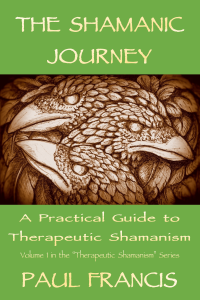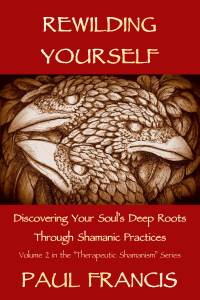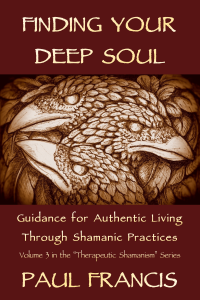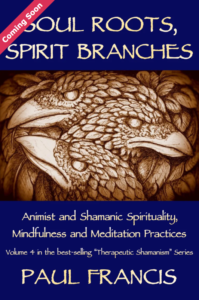
Animist and Shamanic Spirituality, Mindfulness and Meditation Practices
Reconnecting to the Sacredness of the World
Drawing on ancient animist knowledge and shamanic spiritual (upper-world) practices and applying these to modern life, this book is full of eye-opening and profound insights and is grounded in effective and practical exercises. If you are interested in cultivating a spiritual awareness in your everyday life that is:
- sane, attainable and free of dogma, beliefs and clutter
- life-affirming, embodied and life-enhancing
- rooted in the natural world and in the sacredness of all life
then this book is an offering to you.
For tens of thousands of years, our ancestors were alive to the sacredness of the world around them. For them, the spiritual was not something separate from the world, but their everyday and living experience of the world.
In deconstructing the myths and clutter of modern-day spirituality and showing how we have lost our way, Paul Francis guides us back to these deep roots (and wide branches) of our original, healthy spirituality, one that is of service and of use to the world. He eloquently shows us how this is needed not just for our own spiritual development, but vital if we are to heal our profoundly broken relationship with the world around us and begin to put right the damage we have caused. A spirituality that, although ancient, is still deeply relevant and needed now more than ever.
For those unfamiliar with shamanic spirituality and Upper-World practices, the book is a practical and comprehensive guide. For those familiar with other spiritual practices, it offers unique and refreshing perspectives and insights.
An excerpt from the Introduction to the book (the finished version may vary, once the book is sent for publication):
How the Book Is Laid Out
In the later chapters of this book, we will discover what the shamanic Upper-World really is, and the ways in which it differs from the Lower-World. This will include exploring the various beings, environments, and practices that we tend to encounter in Upper-World journeying. We will also explore what Upper-World journeys are for − what the point of them is − and their role in developing a balanced shamanic practice.
To be able to do all this though, because the Upper-World is the realm of Spirit, we first need to understand what shamans mean when they talk about Spirit. For although shamanism has some similarities with other spiritual practices, there are some crucial differences too. To understand what those similarities and important differences are, we will need to get clear about what shamanic spirituality really is (and equally importantly, what it is not), and so that is where we will begin our journey, in chapter one of this book.
In chapter two, having gained a deeper understanding of shamanism, and specifically, the approach to shamanism and animism that these books are about, we can then explore how shamanism is similar to other spiritual practices, and how it differs too. In doing this, we will see how (and why) we abandoned the original Earth-centred spirituality of our hunter-gatherer ancestors, and how spirituality became hijacked and pressed into service in the domestication of ourselves and our domination of the world around us. We will look at how modern-day spiritual thinking is usually hierarchical, and how this way of seeing things has become so ingrained in us that most people simply take spiritual hierarchy as a given fact. We will explore how spiritual hierarchy is not a “fact” though, but an idea that developed only relatively recently in human history, and how adopting it has damaged not only our relationships with each other as humans, but broken our relationship with nature and the other-than-human worlds too.
In chapter three, we will explore how the non-hierarchical and nature-based spirituality of animism can help us heal these damaged and broken relationships. We will see how it can give us another way of seeing and experiencing ourselves and the world around us – practical knowledge, wisdom, and practices that can help us to begin to recover and live again in “right-relationship” with each other and with the other-than-human too. In doing this, we will also explore the (maybe surprising) role that insights from psychotherapy can have in helping in this process of our recovery.
In chapter four, we will turn to looking at the nature of Spirit in more detail. We will explore shamanism’s understanding of “Great Spirit”, “Father Sun”, and “Mother Earth”, and how their interaction and different natures create the shamanic realms. We will see how this accounts for the differences between these realms, and how the realms relate to different parts of ourselves – our Spirit, Soul, body, ego and, in particular, our Aware Self.
In chapter five, we will look at mindfulness and the cultivation of the Aware Self. We will look below the surface details of meditation practices, to get a deeper understanding of what meditation is and how it works, from both a shamanic and a psychotherapeutic point of view. In doing so, we will see how there are meditation practices even for people who have tried meditating and think that it “doesn’t work” for them. We will look at how the different practices fit in to shamanic work, and what their role is in developing a shamanic practice. We will also see how shamanism can contribute to other mindfulness and meditation practices and in doing so, open new ways of working.
In chapter six, we turn to Upper-World shamanic journeys and what happens in them. This will include exploring topics such as:
- Finding Upper-World Guides.
- Finding your Upper-World “Self” or “Spirit”.
- How the Upper-World can help you develop healthy perspective and detachment (whilst staying grounded and healthily compassionate too).
- Upper-World healing practices, including the use of shamanic artifacts, light, song and sound.
- Upper-World places of convalescence and healing.
- The “Council of Elders” and its role in the removal of entanglements, unhealthy contracts, and “curses”.
- The difference between god and goddesses on the one hand, and Gods and Goddesses on the other.
- Honouring both the Sacred Masculine and the Sacred Feminine.
In chapter seven, we will look at the role of rituals and ceremonies in spiritual practices. We will look at how they work and may be helpful, and how at other times they may get in the way. We will look at the issue of offerings and sacrifices, and finish by looking at cultivating healthy practices such as cleansing and energy hygiene, grounding and embodiment, respectful relationship, loving kindness, and gratitude.
In chapter eight, having the knowledge and practices of the previous chapters under our belt, we look at how to bring these together into a healthy, embodied and living shamanic spiritual practice. Returning to the subject of hierarchical spirituality, we will look at the issue of spiritual power-dynamics. We will look at how to spot unhealthy relationships with physical human spiritual teachers, and with shamanic Spirit Guides too, and how to cultivate healthy relationships instead. We will also explore how ungrounded spirituality has damaged our relationship not only with the sacred Feminine and Mother Earth, but with the sacred Masculine and Father Sky too, and explore practices for healing this.
In chapter nine, we finish by looking at what shamanic ethics might look like, and how this can be a practical guide to living an ethical shamanic spiritual life in the world.
Chapter nine is followed by an appendix. This is in a “question and answer” format. When I began the Therapeutic Shamanism books, in deciding what to write, I drew heavily on my experience of the common questions students asked when I was teaching. Since publishing the first books though, I have noticed a change in the questions that students now ask. Many students these days come to the courses having already read the books. Consequently, the questions they now ask are often more in-depth and searching. I love thinking about the questions they ask, not just the questions themselves but also about what they reveal in terms of the thoughts and beliefs that are behind them and how to address these. What I have found is that the answers are usually of use to more than just the person asked the question. Because of this, I now keep a record of questions students ask, and will include the most interesting and useful ones (and my answers!) as an appendix in all the books in the series, beginning with this one. I hope you will enjoy these “questions and answers” as much as I do and find them useful in developing your shamanic practice.
After the appendix, you will find various other sections including: a bibliography; information about the next books in this series; shamanic definitions of terminology; resources for exploring further (including information on training courses in Therapeutic Shamanism, how to find a shamanic practitioner, and other online resources including videos, articles, blogs, free shamanic drumming tracks and much more).
To be kept informed and find out when Soul Roots, Spirit Branches is released, you can subscribe to our newsletter below.
Praise for "The Shamanic Journey", the first book in this series.
A book that shines in the darkness
This book is one, huge, big heart of giving
It's rare to encounter a book that inspires so much spiritual practice with such clear guidance
Honest and thought-provoking
Beautifully written and like nothing I have ever read on shamanism before
Excellent for beginners and more advanced practitioners
This book is the fourth in the best-selling “Therapeutic Shamanism” series. It is not necessary to have read the other books in the series, however this book does assume prior knowledge of the shamanic realms, and the ability to do shamanic journeys for yourself, all of which is covered in the earlier “Therapeutic Shamanism” books.
Get news about "Soul Roots, Spirit Branches"
Subscribe to our Newsletter
We promise not to bombard you with emails! The newsletter only goes out a few times a year and you can unsubscribe at any time.
Would you like to learn More about Therapeutic Shamanism?
Courses
Learn about “Therapeutic Shamanism” through our experiential courses. Browse our courses and start learning now.





